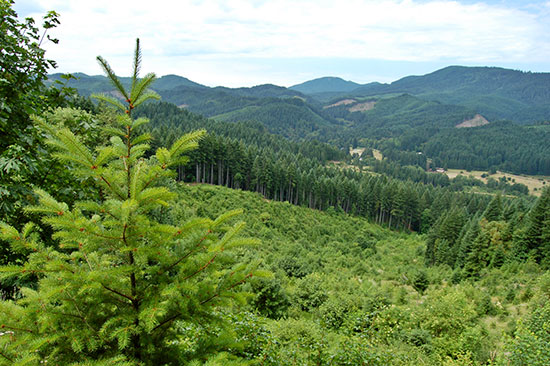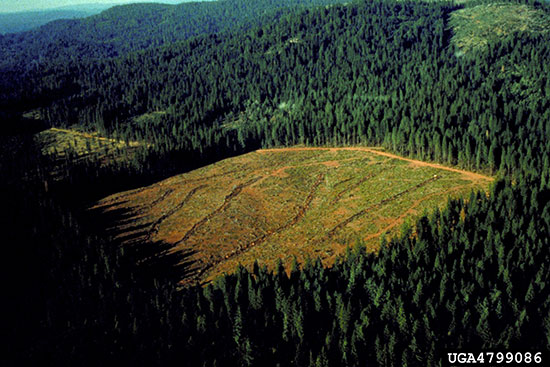The Impact of Wood Use on North American Forests

Photo courtesy of the Oregon Forest Resources Institute
Different age classes across the forest landscape
Over time, one of three things happens:
▶When the trees get older, they start to decay and slowly release the stored carbon.
▶The forest succumbs to wildfire, insects or disease and releases the carbon quickly.
▶The trees are harvested and manufactured into products, which continue to store much of the carbon (Wood material is approximately 50 percent carbon by dry weight.) In the case of wood buildings, the carbon is kept out of the atmosphere for the lifetime of the structure—or longer if the wood is reclaimed at the end of the building’s service life and either re-used or remanufactured into other products.
Unless the area is converted to another use, the cycle begins again as the forest regenerates and young seedlings once again begin absorbing CO2.
The other important aspect to wood’s relatively light carbon footprint is the fact that wood products require less energy to manufacture than other major building materials,17 and most of that comes from renewable biomass (i.e., sawdust, bark and other residual fiber) instead of fossil fuels. In the U.S., biomass fuels provided 75 percent of the energy required at wood product facilities in 2010.18
In Canada, bioenergy accounts for 58 percent of the energy used by the entire forest industry.19
A great deal of research has been undertaken to determine how forests can be managed to maximize their carbon benefits. According to a report from the Society of American Foresters,20 numerous studies of forest carbon relationships show that a policy of active and responsible forest management is more effective in capturing and storing atmospheric carbon than a policy of hands-off management that precludes periodic harvests and use of wood products.
While acknowledging that it is not appropriate to manage every forested acre with a sole focus on carbon mitigation, the report’s authors conclude (among other things), that:
▶Wood products used in place of more energy-intensive materials, such as metals, concrete and plastic reduce carbon emissions, store carbon, and can provide additional biomass that can be substituted for fossil fuels to produce energy.
▶Sustainably managed forests can provide greater carbon mitigation benefits than unmanaged forests, while delivering a wide range of environmental and social benefits including timber and biomass resources, jobs and economic opportunities, clean water, wildlife habitat, and recreation.
As with all aspects of forestry, choosing not to manage also has consequences, and this also impacts carbon. Young, healthy forests are carbon sinks because they’re actively absorbing carbon dioxide as they grow. As forests mature, they generally become carbon cycle-neutral because primary productivity declines. Many continue to store substantial amounts of carbon indefinitely—old growth forests in the U.S. and Canada represent significant carbon sinks—but the probability of massive carbon loss also increases. Where forests are killed by large-scale natural disturbances (such as wildfires and insect or disease infestations), they emit their stored carbon without providing the benefits available through product and energy substitution.

Photo courtesy of Philip McDonald, USDA Forest Service, Bugwood.org
This forest in the northern Sierra Nevada mountains was clearcut to support the natural regeneration of Ponderosa Pine, Douglas-fir, Sugar Pine, California white fir, and Incense-cedar.










